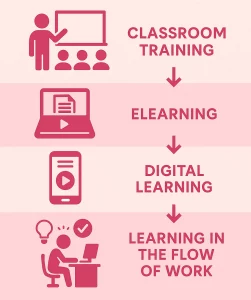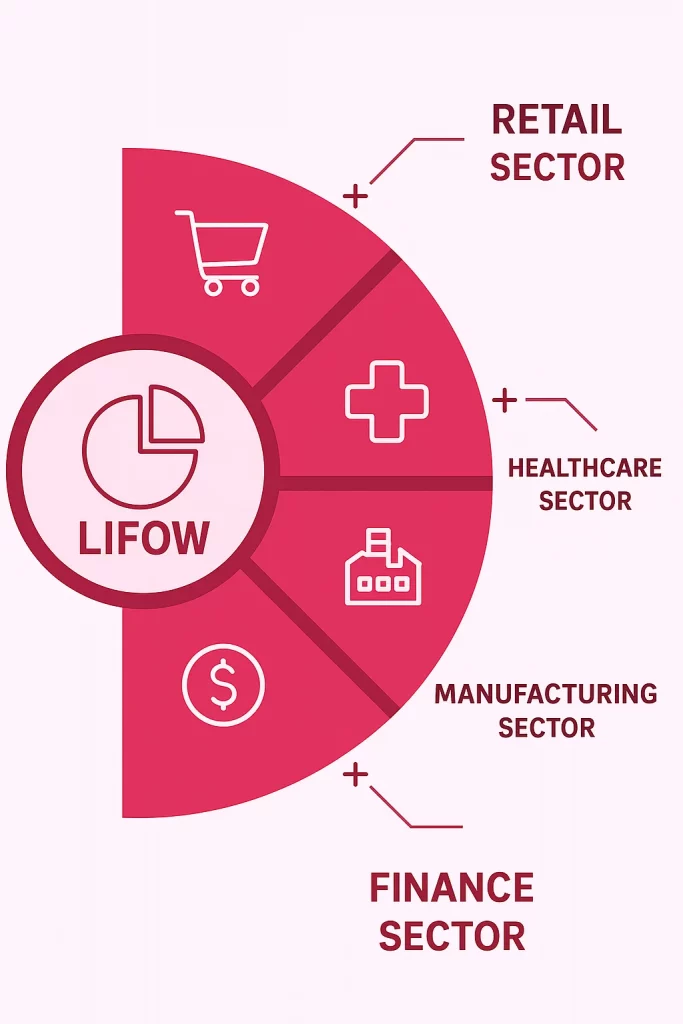Workplace learning is evolving rapidly, not just in format, but in purpose and delivery. In 2018, Josh Bersin introduced the concept of “Learning in the Flow of Work” (LIFOW), a framework that reimagines training as an immediate, context-sensitive experience rather than a separate, time-consuming event.
This shift is backed by significant market momentum. The global corporate training market was valued at $361.5 billion in 2023 and is projected to reach $805.6 billion by 2035, growing at a CAGR of 7.0%.
Moreover, employee preferences are evolving. A notable 92% of employees consider training a deal breaker when choosing between two potential employers, highlighting the importance of on-the-job learning opportunities.
At Beetsol, we recognize the importance of integrating learning into the daily flow of work. Our solutions are designed to embed learning resources directly into the tools and platforms employees use, facilitating continuous development without hindering productivity. This guide breaks down how it works, why it matters, and how to implement it effectively across your organization.
What is Learning in the Flow of Work?
Learning in the Flow of Work is a modern training strategy that delivers knowledge and resources right at the moment of need within the digital environments employees already use. Whether it’s a CRM, chat tool, or internal system, learners gain access to relevant content without pausing their tasks or switching platforms.
Rather than separating learning from work, this approach makes learning an invisible support layer that strengthens decision-making, boosts productivity, and enables faster onboarding or upskilling all without disrupting workflows.
How Corporate Training Evolved

The evolution of corporate learning mirrors changes in technology and employee expectations:
- Classroom Training: Traditional instructor-led sessions requiring physical presence and significant time away from work.
- eLearning: Digitized courses that enabled self-paced learning but often remained separate from day-to-day tools.
- Digital Learning: Mobile, video-based, or LMS-integrated content that began breaking silos but still demanded separate attention.
- Learning in the Flow of Work: A context-driven model where learning happens as part of the job, seamlessly and instantly.
This progression reflects a growing need for agile, embedded learning solutions that adapt to real-world work environments and reduce friction.
Why Do We Need Learning in the Flow of Work?
Modern work environments are high-speed and high-pressure. Employees face tight schedules, constant distractions, and increasing complexity in roles. Asking them to disengage from work to sit through long training modules is no longer effective.
LIFOW solves some key pain points:
- Time Constraints: Learning fits into existing schedules instead of competing with tasks.
- Contextual Relevance: Employees absorb knowledge better when it’s tied to a real-time need.
- Reduced Cognitive Load: Microlearning helps retain information more effectively than dense training blocks.
- Better Performance: Immediate access to resources leads to faster, smarter decision-making.
Ultimately, LIFOW empowers employees to perform while learning, not after it.
The Benefits of Learning in the Flow of Work
Implementing Learning in the Flow of Work (LIFOW) offers numerous advantages that align with the dynamic needs of modern workplaces. Let’s delve into these benefits with illustrative examples:
1. Immediate Application of Knowledge
By integrating learning resources directly into daily tasks, employees can apply new information instantly, reinforcing retention and understanding.
Example: A customer service representative encounters a complex query. Instead of pausing to search through manuals, a contextual help widget within their CRM provides step-by-step guidance, enabling them to resolve the issue promptly.
2. Enhanced Employee Engagement
When learning is seamlessly woven into work processes, it becomes more relevant and engaging, leading to increased motivation and job satisfaction.
Example: A sales associate receives real-time tips on upselling techniques while interacting with a client, making the learning experience directly applicable and engaging.
3. Increased Productivity
LIFOW minimizes disruptions by eliminating the need for separate training sessions, allowing employees to learn without stepping away from their responsibilities.
Example: A software developer accesses a code snippet library integrated into their development environment, reducing time spent searching for solutions and enhancing coding efficiency.
4. Cost-Effective Training
By reducing the need for formal training sessions and associated logistics, organizations can significantly cut training costs while maintaining effective learning outcomes.
Example: A retail chain implements microlearning modules accessible via employees’ mobile devices, eliminating travel and accommodation expenses for centralized training programs.
5. Improved Knowledge Retention
Learning in context aids memory retention, as employees can immediately apply new information, reinforcing learning through practice.
Example: A healthcare professional receives instant refreshers about hygiene protocols during patient interactions, reinforcing best practices and ensuring compliance.
6. Scalable Learning Solutions
LIFOW allows organizations to deploy consistent training across diverse locations and teams, ensuring uniform knowledge dissemination.
Example: A multinational corporation integrates compliance training into its global HR platform, ensuring all employees receive timely and consistent information regardless of location.
Practical Applications of Learning in the Flow of Work

Understanding how Learning in the Flow of Work (LIFOW) is powered by a modern Learning Management System (LMS) helps illustrate its real value. Below are examples of how organizations can use an LMS like Beetsol’s to deliver contextual, just-in-time learning directly within daily workflows:
Retail Sector: Smart Product Training via LMS Integration
Through Beetsol LMS, retail associates can access microlearning modules by scanning product barcodes with their mobile devices. The LMS for Retail Industry delivers instant, bite-sized lessons about product features, use cases, and upselling techniques, without requiring employees to leave the sales floor or switch platforms.
Healthcare: Embedded Learning for Clinical Compliance
Integrated with hospital management software, the LMS delivers updated training modules on hygiene protocols, new procedures, or equipment usage. When a nurse logs into the system for patient updates, the LMS recommends relevant learning content based on the current case—ensuring knowledge is applied immediately and accurately.
Manufacturing: On-the-Job Technical Support via LMS
Maintenance teams receive just-in-time guidance through the LMS, accessible on tablets or wearable devices. When scanning a machine’s QR code, the LMS for the Manufacturing provides role-based tutorials, safety checklists, or walkthrough videos to ensure accurate servicing, reducing machine downtime and errors.
Finance: Real-Time Compliance Learning
For employees in finance, regulatory updates can be overwhelming. Beetsol’s LMS for Finance industry can automatically push short, mandatory learning modules to analysts or advisors when new financial regulations are introduced—keeping teams compliant without interrupting productivity.
How to Implement Learning in the Flow of Work

To embed learning naturally into the workday, organizations should focus on strategy, tools, and culture:
1. Identify High-Impact Moments
Pinpoint where employees typically encounter friction, confusion, or frequent questions in their daily roles. These are the ideal touchpoints for embedded learning.
2. Use the Right Technology
Integrate learning tools directly within work platforms—whether it’s a CRM, helpdesk software, or intranet. Look for systems that allow for contextual triggers or in-app support.
3. Create Targeted, Bite-Sized Content
Design microlearning assets that answer one question or solve one problem at a time. Focus on brevity, clarity, and accessibility.
4. Foster a Learning-First Culture
Encourage managers and team leads to promote on-the-spot learning. Recognize those who seek knowledge proactively.
5. Measure, Refine, Repeat
Track engagement and performance data to understand what’s working. Continuously update content and delivery formats based on feedback and usage patterns.
Best Practices for Embedding Learning in the Flow of Work
To get the most from your LIFOW strategy:
1. Make it Seamless
Learning tools should feel like part of the platform, not an external layer.
2. Prioritize Relevance
Content must solve immediate problems—not just offer general theory.
3. Ensure Accessibility
One-click access from within apps or workflows drives adoption.
4. Incorporate Feedback Loops
Use employee insights to refine and expand learning materials.
5. Update Frequently
As roles and systems evolve, so should your content library.
How Beetsol Can Help with Learning in the Flow of Work
At Beetsol, we help organizations turn workplace learning into a competitive advantage by designing smart, contextual, and integrated learning experiences.
Here’s how we support LIFOW:
Personlized Learning Modules
We help automate learning path suggestions aligned with your workflows and employee roles—so learning always fits the moment.
Seamless Platform Integration
Whether you’re using Salesforce, Microsoft Teams, or custom tools, we embed learning experiences where employees already work.
Insight-Driven Optimization
Track what content is working, who’s engaging, and where improvements are needed. Beetsol’s analytics help you build a smarter, evolving L&D ecosystem.
Embracing a New Era of Workplace Learning
The traditional model of workplace training—characterized by scheduled sessions and separate learning environments is giving way to a more integrated approach. Learning in the Flow of Work represents a significant shift towards embedding learning within daily activities, making it a natural and continuous part of the job.
This evolution is driven by the need for agility, relevance, and efficiency in employee development. By aligning learning opportunities with real-time tasks, organizations can foster a culture of continuous improvement, adaptability, and proactive skill enhancement.
At Beetsol, we are committed to facilitating this transition by providing solutions that seamlessly integrate learning into your existing workflows, ensuring that your team is equipped to meet the challenges of today’s dynamic work environment.
Ready to Grow in the Flow?
The future of corporate learning isn’t about stepping away from work, it’s about learning while doing. With the right strategy and tools, especially an AI-powered LMS, Learning in the Flow of Work becomes a powerful lever for productivity, performance, and retention.
Let Beetsol’s AI-powered LMS guide your organization toward a smarter, faster, and more engaging learning journey, where knowledge is delivered when and where it’s needed most.
